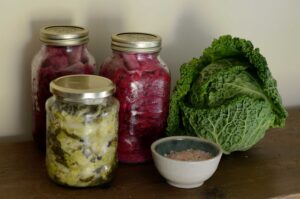Introduction to Food Preservation at Home
You might ask why preserve at home? Preserving food at home offers economic, health, and taste benefits. It reduces food wastage, saves money, and allows control over ingredients, sidestepping harmful preservatives. Freshness and flavor are locked in, enhancing quality.
Definition and History of Food Preservation
Food preservation refers to the practice of delaying the spoilage of food products to ensure their longevity, safety, and quality. This process involves various techniques like canning, freezing, pickling, drying, and fermenting, among others.
Historically, our ancestors utilized natural methods for food preservation. They dried fruits and vegetables in the sun, smoked meats over fire, and fermented dairy products. With the advent of technology, more sophisticated methods such as canning and freezing were introduced in the 19th and 20th centuries respectively. Today, food preservation continues to evolve, incorporating both traditional and modern methods, aimed at maintaining nutritional value while extending shelf life.
Different Methods of Food Preservation
There are numerous methods available for food preservation, each with its unique advantages and applications.
- Canning: This process involves placing foods in jars or similar containers and then heating them to kill microorganisms that cause decay. It’s a popular method for preserving various fruits, vegetables, and meats.
- Freezing: Freezing halts the growth of bacteria, yeast, and molds, thereby preserving food. It is an easy and convenient method widely used for a range of food items from fruits and vegetables to meats and baked goods.
- Drying: Drying involves removing water from food to inhibit the growth of bacteria. Sun drying, air drying, and electric dehydrating are commonly used methods to dry fruits, vegetables, herbs, and meats.
- Pickling: In pickling, an acidic solution, often vinegar, is used to prevent bacterial growth. Foods like cucumbers, peppers, and onions are often preserved this way.
- Fermenting: Fermentation uses beneficial bacteria to preserve food and often enhances its nutritional value. It is commonly used for dairy products, vegetables, and beverages like yogurt, sauerkraut, and kombucha.
Each of these methods has its own set of procedures and safety guidelines that need to be followed to ensure the proper preservation of food and prevent foodborne illnesses. It’s important to note that the preservation technique chosen often depends on the type of food being preserved and the desired end result.
Why Preserve Food at Home
Preserving food at home offers significant economic benefits, paramount of which is the reduction of food wastage. Too often, fresh foods spoil before they can be consumed, leading to wastage. By using preservation techniques, we can extend the shelf life of food, ensuring that nothing goes to waste. Moreover, preserved foods can serve as handy meals when you’re short on time, reducing the need for expensive, often less healthy, ready-made alternatives or takeaways. Additionally, home preservation allows us to take advantage of seasonal abundance. By preserving seasonal fruits and vegetables, we can enjoy these foods year-round without paying premium prices for out-of-season produce. Altogether, these factors contribute to significant potential savings, making food preservation a savvy choice for budget-conscious households.
Health Advantages of Home Food Preservation
An additional advantage of preserving food at home is the control it offers over the ingredients used. This is particularly beneficial for individuals who have specific dietary needs or preferences. You can adjust the amount of sugar, salt, or fat in your preserved foods based on your dietary requirements or health goals.
Moreover, home preservation gives you the opportunity to avoid the preservatives and additives commonly found in commercially preserved foods. These substances, while useful in prolonging shelf life and enhancing flavor, can sometimes have negative health implications when consumed in large amounts over time. By preserving food at home, you can enjoy the convenience of preserved foods with the peace of mind that comes from knowing exactly what’s in them. This not only contributes to a healthier diet but also encourages a more mindful approach to food consumption.
Taste and Quality: Freshness and Flavor Preservation
One of the most compelling reasons to preserve food at home lies in the unmatched freshness and flavor it allows. When you preserve fruits and vegetables at their peak ripeness, you’re essentially capturing and sealing in their optimum taste and nutritional quality. This process surpasses any commercially preserved foods that often lose their vitality due to long storage and transport times. Plus, the freedom to use high-quality, locally sourced ingredients further enhances the flavor of preserved foods. Enjoying a jar of homemade berry jam in the middle of winter or savoring the taste of pickled cucumbers long after the summer’s end can be a delightful culinary experience, reminding us of the bounty and vibrancy of different seasons. This authenticity of taste and quality is a luxury that only home preservation can truly afford.
Methods of Home Food Preservation
Canning: Overview
Canning is a food preservation method that involves the process of heating and sealing food in jars to kill microorganisms and enzymes that could lead to spoilage. It’s a versatile method that can be used for a wide variety of foods, from fruits and vegetables to meats and seafood.
Benefits of Canning
The benefits of canning extend beyond simply extending the shelf life of food. Canning allows you to store food without the need for refrigeration, making it an excellent option for long-term storage. It also retains the nutritional value of food, as the high heat used in the canning process can kill bacteria without significantly impacting the nutrients within the food. Furthermore, canning enables you to have access to a variety of foods year-round, regardless of seasonal availability.
Step-by-step Guide to Canning
- Preparation: Start by selecting fresh, high-quality food. Wash and cut the food as necessary.
- Jar selection and preparation: Use only jars and lids designed for canning. Wash jars and lids in hot soapy water, rinse them well, and then sterilize them by boiling for 10 minutes.
- Filling the jars: Pack the food into the jars, either raw or pre-cooked. If a canning liquid (like brine or syrup) is required, now is the time to add it.
- Sealing the jars: Place the lids on the jars and tighten appropriately, not overly tight.
- Processing the jars: The jars are then processed in a canner, either a boiling water bath or a pressure canner, depending on the type of food.
- Cooling and storage: After processing, let the jars cool, check the seals, and then store in a cool, dark place.
With these steps, you can preserve your food at home, knowing precisely what goes into it, and enjoy your preserved produce all year round.
Freezing
Freezing is another popular method of food preservation. It works by slowing down the enzyme activity that causes food to rot. When done properly, freezing can preserve food with its nutrients intact.
Benefits of Freezing
Freezing has several advantages. First, it is one of the easiest, most convenient, and least time-consuming methods of preserving food. It also maintains the nutritional quality of the food, as freezing retains most of the vitamins and minerals present in the fresh produce. Moreover, unlike canning, freezing doesn’t require any special equipment – a common household freezer is sufficient.
Best Practices for Freezing
- Selection of Produce: Similar to canning, choose fresh, ripe, and high-quality foods for freezing.
- Preparation: Clean the produce thoroughly. Some foods, like fruits, can be frozen directly. Others, like vegetables, often need blanching before freezing.
- Packaging: Use only materials designed for freezing. Make sure the packaging is airtight to prevent freezer burn. A seal-a-meal is great for this!
- Freezing: Place the packaged food in the coldest part of the freezer. Ensure they are not packed too tightly together to allow for proper air circulation.
- Defrosting: Defrost food safely, preferably in the refrigerator.
Mastering the art of freezing can help you to maintain a diverse, healthful, and seasonal diet all year round, with minimal effort.
Drying
Drying is one of the oldest methods of food preservation. It works by removing the moisture content from the food, inhibiting growth of microbes and decay. There are various methods of drying, such as sun drying, air drying, and using a dehydrator or an oven.
Benefits of Drying
Drying imparts several benefits. Primarily, it effectively preserves food by slowing down the action of bacteria, yeasts, and molds through the removal of water. Drying also condenses the food, reducing its size and making it more portable and convenient for storage and transportation. Additionally, some dried foods, like dried fruits, can offer a different, often richer, taste than their fresh counterparts.
Best Practices for Drying
- Selection of Produce: Opt for fresh, ripe, and high-quality food for drying, just as you would for canning or freezing.
- Preparation: Clean and cut the produce into uniform sizes to ensure even drying.
- Drying: Depending on the method of drying you choose, this can take from a few hours to several days. Make sure the food is completely dry, but not overly so, to prevent it from becoming too hard or losing its nutritional value.
- Storage: After drying, cool the food and pack it into airtight containers. Store these in a cool, dark place.
- Rehydration: To use dried foods in cooking, you’ll often need to rehydrate them. Do this by soaking in water for a specific amount of time, or by directly adding them into soupy dishes or stews.
With an understanding of drying, you can preserve a wide variety of foods, ensuring you have seasonal produce available to eat all year round.
Safety Measures in Home Food Preservation
When engaging in home food preservation, the importance of cleanliness and sanitation cannot be overstated. It is paramount to ensure that all utensils, containers, and surfaces that come into contact with your food are cleaned and sanitized appropriately to prevent contamination. Unclean environments can lead to the growth of bacteria, yeast, and molds, which could not only spoil your preserved food but can also pose serious health risks.
Likewise, proper storage practices play a crucial role in preserving the quality and safety of your preserved foods. After ensuring your food is adequately preserved and packaged in an airtight container, the container should be stored in a cool, dark place to maintain the food’s optimal quality. Additionally, it’s essential to regularly check on your stored food to monitor any signs of spoilage or contamination. Proper storage practices help prolong the shelf life of your preserved food, contributing to food sustainability and reducing waste.
Conclusion
In conclusion, home food preservation presents an array of benefits, including prolonged shelf life, reduced food waste, and the opportunity to savor seasonal produce throughout the year. The techniques such as drying, when carried out correctly and safely, provide a practical and economical solution to food storage. Remember, maintaining cleanliness and adhering to proper storage guidelines are pivotal to successful food preservation. So, don’t hesitate to try these methods at home. Discover the joy of creating your preserved goods, and taste the difference that home-preserved food brings. A world of flavors awaits you in your kitchen, ready to be explored and enjoyed.


